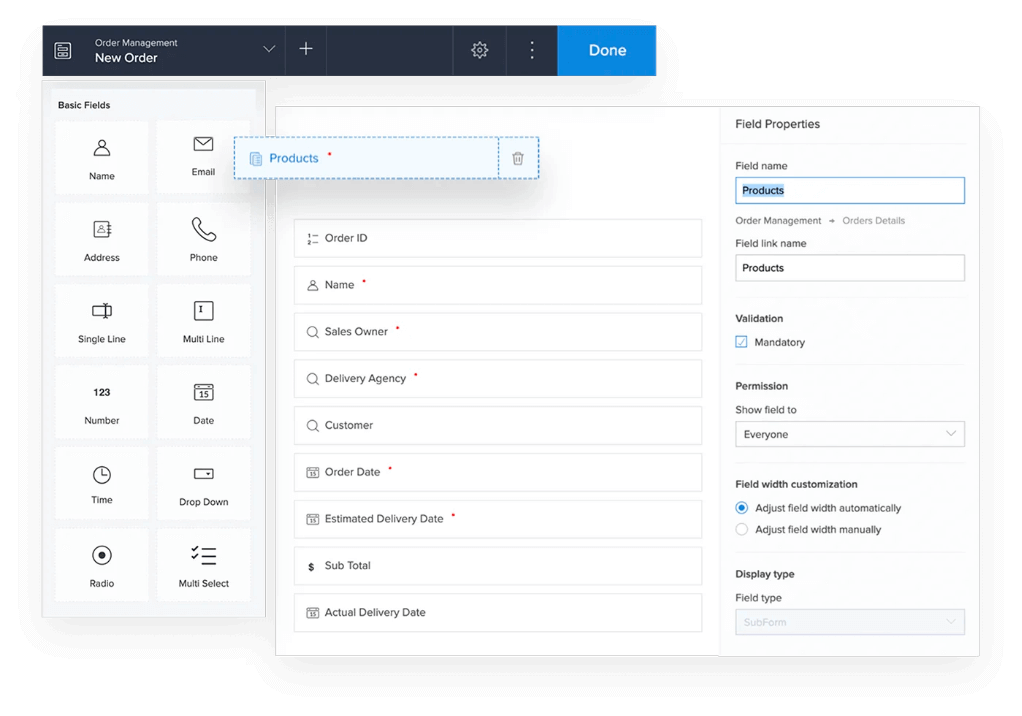Good Facts To Selecting application development with Low-code platforms
Good Facts To Selecting application development with Low-code platforms
Blog Article
Benefits Of Low-Code Application Development In Terms Of Accessibility For Non-Developers
Because of a variety of reasons the development of low-code applications is more accessible for non-developers. These are sometimes referred to as "citizens developers."
Drag-and-Drop Builders: Low-code systems have drag-and-drop interfaces that allow non-developers to create applications visually without having to write code. This makes development more accessible for people who have no or little technical skills.
WYSIWYG editors The WYSIWYG editors "What You See Is What You Get" editors allow users to build interfaces and workflows that are identical to the finished version. This makes it easier to use and understand.
Simplified Workflow and Logic Design:
Visual Workflow Design: Users can easily create business processes and application logic by using diagrams, flowcharts and models. They are easier to work with than traditional programming.
Pre-built Logic components: Low-code platforms include logic components already built (e.g. conditional statements and loops), which can be configured easily and without the need for complex programming.
Reusable Components and Templates:
Libraries of Templates that are pre-built Numerous platforms that provide low-code also have a library of template types for the most common applications. This lets developers begin their journey quickly and effortlessly and non-developers to modify the templates however they see the need.
Reusable Widgets and Modules Users can use reusable widgets. This simplifies the creation and helps to reduce the need for deep knowledge.
Guided Development and Tutorials
Step-by-Step Instructions Platforms typically offer tutorials that are on screen, guided development routes as well as other tools to assist people who are not developers to create applications.
Interactive Tutorials - Interactive tutorials which allow you to engage with the platform can assist you in learning and build confidence.
Integration with existing tools:
Seamless Integration - Low-code platforms can be easily integrated with existing business tools and systems (e.g. ERP CRM), allowing even non-developers to create apps that fit to their workflows.
APIs/Connectors: The built-in APIs/connectors enable non-developers to connect their applications to external services.
Collaboration Features:
Team Collaboration: Features, such as real-time collaboration and shared workspaces, enable professionals and non-developers to collaborate efficiently.
Role Based Access Control You can give non-developers certain roles with the appropriate access level, so that they can be part of the development process while not compromising on security or functionality.
Automated Debugging, Debugging, and Testing
Low-code platforms have tools for testing and debugging that are built in. They automatize this procedure, making it much easier for nondevelopers to ensure their apps function.
Error Highlighting: Whenever problems occur, the platform highlights the errors and suggests solutions, guiding non-developers through troubleshooting steps.
Overall, the benefit of low-code application development in terms of accessibility for non-developers is in its ability to democratize the development process. With its visual-friendly tools and experiences, low code platforms enable business owners to actively take part in and manage applications. See the most popular Low-code Platform for application development blog for blog info including app dev platform, cross platform mobile app development, cross platform mobile app development, database in azure, application modernization software, cross platform app dev, ms azure sql, multiplatform mobile app development, rapid applications, rad development and more.
Low-Code Application Development Offers Numerous Benefits, Particularly In Terms Of Cost-Effectiveness
Low-code applications offer a variety of advantages when it comes to cost-effectiveness. Businesses that are looking to optimize budgets can take advantage of this approach while also delivering high-quality applications. These are the main benefits: Reduced development costs:
Lower Coding Requirement: Lower programming platforms eliminate the requirement to code manually which saves developers time as well as money. This results in lower labor costs.
Less developers: Since low code development is speedier and more simple and less complex, there are fewer developer resources required. Costs for hiring and staffing can be reduced significantly.
Speedier Time To Market
Accelerated Development Cycle: Visual development tools and pre-built components offered by low-code platforms allow for rapid application development, allowing companies to get their products on the market more quickly. This can translate into more revenue and sales as well as improved position in the marketplace.
Rapid prototyping allows businesses to quickly develop prototypes and then test them, reducing the time spent in the development phase and allowing for faster iterations based on feedback from users.
Reduce Maintenance Costs
Because of their modular design and common components, low-code platforms usually simplify the maintenance of applications. This reduces the cost of ongoing maintenance and support.
Automated Patches and Updates: Low-code platforms are able to handle patching and updating applications completely. This guarantees that your application remains safe and always up to date without extensive manual intervention.
Efficient Resource Utilization:
Low-code platforms enable businesses and other non-developers to participate in the process of development. This allows businesses and employees to collaborate, thereby reducing the dependency on high-paid developers.
IT departments can concentrate on Strategic Initiatives: Instead of being bogged down by routine development tasks IT departments are able to focus their efforts on strategic initiatives that improve productivity and efficiency.
Pricing models that can be scaled:
Subscription-Based Pricing: A lot of low code platforms offer flexible subscription-based pricing that scales according to use. This allows businesses to match their spending to their actual needs and increase.
Pay-Assosiated Options: Some platforms offer pay-assosiated alternatives. These options ensure that companies pay only for the resources utilized, which is beneficial to small and new businesses with limited funds.
Reduce the cost of Third-Party software:
Low-code platforms are often equipped with integrated functionalities that eliminate the need to purchase extra software or tools. This could save you money on subscriptions and licensing fees.
Pre-Built Integrations: The existence of pre-built integrations for popular platforms and services eliminates the requirement for custom-built development, thereby saving time and money.
Better ROI:
Faster Return on Invest Rapid development: By combining lower costs and a quicker time to market, businesses are able to get a higher return on their investment (ROI).
Increased Ability. Companies are able to adjust quickly to the changing market conditions and customer requirements. This will allow them to remain relevant, and they are able to take advantage of new opportunities.
Train for Less:
User-friendly interfaces: Low-code systems offer user-friendly and intuitive interfaces that help reduce the time required to learn. They also minimize the need for lengthy training programs.
Accessible Resources that are accessible. A lot of low-code platforms offer comprehensive training material, tutorials, as well community support. They reduce the need to undergo formal training, which is costly.
Collaboration can be streamlined.
Collaboration Tools: These tools enhance communication and coordination between teams, resulting in better processes for development and reduced cost of operations.
Unified Development Environment : A unified environment streamlines workflows and lowers the cost associated with managing various tools and platforms.
The cost-effectiveness in low-code app development comes from its ability reduce maintenance and development costs, speed up the time to market, improve resources, and offer different pricing options. These aspects provide significant economic benefits to businesses which makes low-code development a compelling option for organizations looking to maximize their budgets while delivering robust, scalable, high-quality apps. Follow the best the full details for more tips including rapid application design, lowcode no code, low code development platforms, azure sql, develop mobile application, cross platform app dev, develop mobile application, microsoft azure sql, rad application development, build a docker container and more.
The Benefits Of Developing Low-Code For Workflow And Collaboration
Low-code applications offer a number of advantages when it comes to workflow and collaboration, which makes it an the ideal option for companies looking to enhance team productivity and streamline development processes. These are the major benefits.
Unified Development Environment : Low-code platforms offer a unified, single environment where all team members can work together efficiently such as designers, business analysts and others. They remove silos while encouraging better communication.
Visual Development Tools: The graphic drag-and-drop design of low-code platforms makes it easy for non-technical team members to be involved in the development process, while ensuring that the requirements of the business are correctly captured and implemented.
Communication Enhanced
Real-Time Collaboration: Many low-code platforms offer real-time collaboration capabilities like simultaneous editing, commenting and instant feedback. These features allow for continuous communication and decrease the time wasted in back-andforth discussions.
Shared Workspaces: Teams can work together within shared workspaces. They can access edit, discuss and even discuss components of their project. This makes sure that everyone is working towards the same purpose.
A streamlined Workflow Management System:
Built-in Project Management Tools : Low-code platforms usually contain integrated software for managing projects that help teams plan, track, manage, and coordinate their projects for development. This includes task assignments along with progress tracking and management of deadlines.
Workflow Automation: Automating routine tasks and workflows decreases manual effort and errors, allowing teams to focus on more strategic activities and enhancing overall efficiency.
Faster Iteration cycles
Rapid Prototyping Low-Code platforms are ideal for quick prototyping. Iterative development is also feasible, allowing the team to develop, test and improve their apps within shorter time. This allows feedback to be rapidly integrated, and further improvements to be implemented.
Support for agile development: Using agile practices allow teams to work continuously in sprints. This makes it simpler to change and deliver smaller steps to improve functionalities.
Accessibility for non-developers:
Citizens Development: Lowcode platforms permit users of business applications (citizen developers), to create, modify, and maintain applications with no programming expertise. This eases the burden on IT and development teams and can provide faster responses to the business demands.
Training and Onboarding - Simple interfaces, extensive training resources and intuitive interfaces make it easy for new team members get up to speed and boost the overall team's collaboration.
Centralized Documentation and Knowledge Sharing:
Integration of Documentation: Low-code platforms usually include features for creating and maintaining documentation within the platform making sure that all project data is accessible and centrally stored.
Knowledge Repositories Teams are able to create and maintain repositories of knowledge which include best practices, templates, and reuseable elements, which facilitate the sharing of knowledge and reducing the amount of duplicate information.
Consistency and uniformity:
Standardized Components. The standardization of components across different applications guarantees consistency and makes it easier to work on and comprehend by team members.
Governance and compliance Frameworks for governance and compliance that integrate help ensure that development conforms to organizational standards and regulatory requirements. This reduces the risk of noncompliance, and helps applications comply with quality standards.
Feedback Loops and Improvement Loops
Integrated Feedback Systems: Low-code platforms have integrated feedback systems that enable users to give feedback on the applications. The feedback can then be used in the development of the applications.
Continuous Improvement: The capability to rapidly iterate and deploy changes based on feedback assures the continuous improvement of apps which are aligned with the needs of users and business objectives.
Visualization, Reporting and Analysis
Real-time analytics: Built-in analytical and reporting tools provide real-time information about project progress, performances and user interaction. They enable data-driven, informed decision-making.
Visual Workflow Maps Tools for mapping workflows or processes are useful to teams in understanding their workflows. They can also be used to pinpoint bottlenecks and areas that require improvement.
Low-code development of applications is a powerful tool for collaboration and workflow. It connects different teams, improves communication, and automates processes. This creates a flexible, collaborative, and efficient development environment that leads to better-quality applications.